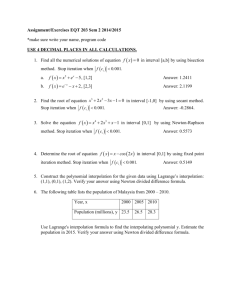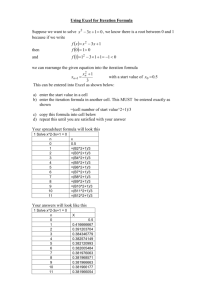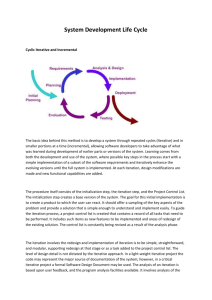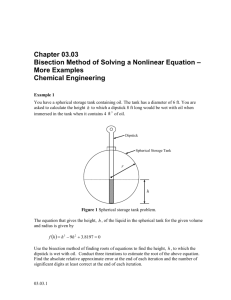Example 1 (Bisection Methods) You are working for `DOWN THE
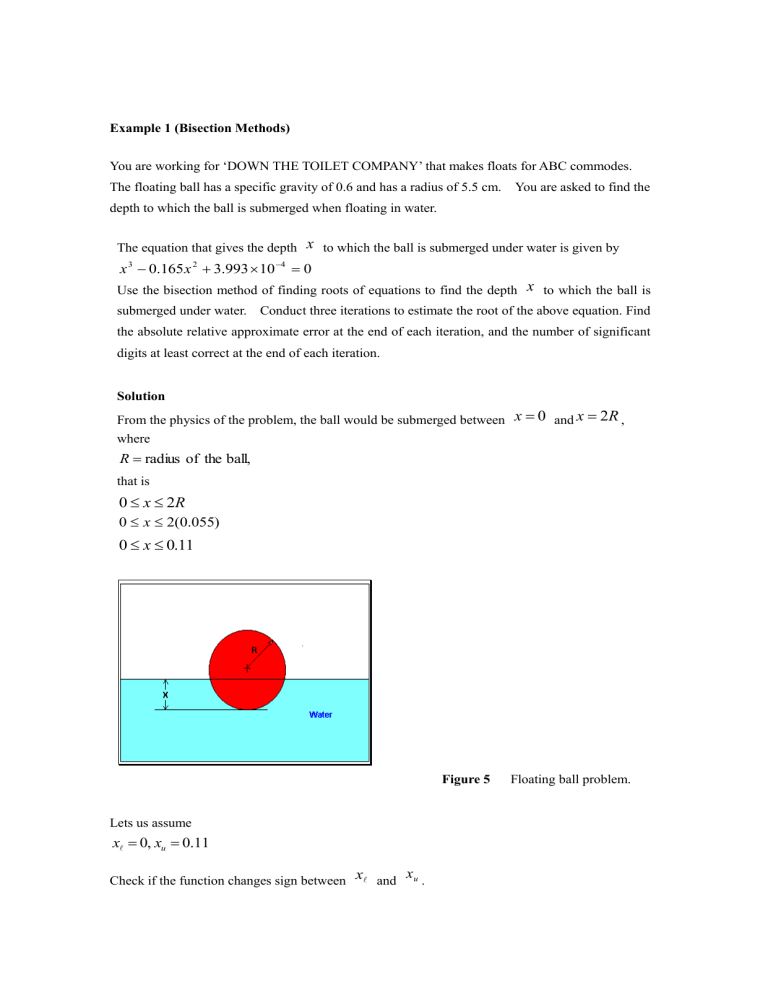
Example 1 (Bisection Methods)
You are working for ‘DOWN THE TOILET COMPANY’ that makes floats for ABC commodes.
The floating ball has a specific gravity of 0.6 and has a radius of 5.5 cm. You are asked to find the depth to which the ball is submerged when floating in water.
The equation that gives the depth x
3
0 .
165 x
2
3 .
993
10
4
0 x
to which the ball is submerged under water is given by
Use the bisection method of finding roots of equations to find the depth x
to which the ball is submerged under water. Conduct three iterations to estimate the root of the above equation. Find the absolute relative approximate error at the end of each iteration, and the number of significant digits at least correct at the end of each iteration.
Solution
From the physics of the problem, the ball would be submerged between x
0
and x
2 R
, where
R
radius of the ball, that is
0
x
2 R
0
x
2 ( 0 .
055 )
0
x
0 .
11
Figure 5 Floating ball problem.
Lets us assume x
0 , x u
0 .
11
Check if the function changes sign between x
and x u .
f ( x
)
f ( 0 )
( 0 )
3
0 .
165 ( 0 )
2
3 .
993
10
4
3 .
993
10
4 f ( x u
)
f ( 0 .
11 )
( 0 .
11 )
3
0 .
165 ( 0 .
11 )
2
3 .
993
10
4
2 .
662
10
4
Hence f ( x
) f ( x u
)
f ( 0 ) f ( 0 .
11 )
( 3 .
993
10
4
)(
2 .
662
10
4
)
0
So there is at least one root between x
and x u , that is between 0 and 0.11.
Iteration 1
The estimate of the root is x m
x
x u
2
0
0 .
11
2
0 .
055 f
m
f
0 .
055
0 .
055
3
0 .
165
0 .
055
2
3 .
993
10
4
6 .
655
10
5 f ( x
) f ( x m
)
f ( 0 ) f ( 0 .
055 )
3 .
993
10
4
6 .
655
10
4
0
Hence the root is bracketed between x m and x u , that is, between 0.055 and 0.11. So, the lower and upper limit of the new bracket is x
0 .
055 , x u
0 .
11
At this point, the absolute relative approximate error
a cannot be calculated as we do not have a previous approximation.
Iteration 2
The estimate of the root is x m
x
x u
2
0 .
055
0 .
11
2
0 .
0825 f ( x m
)
f ( 0 .
0825 )
( 0 .
0825 )
3
0 .
165 ( 0 .
0825 )
2
3 .
993
10
4
1 .
622
10
4
f
m
f
0 .
055
0 .
0825
6 .
655
10
5
1 .
622
10
4
0
Hence, the root is bracketed between x
and x m , that is, between 0.055 and 0.0825. So the lower and upper limit of the new bracket is x
0 .
055 , x u
0 .
0825
The absolute relative approximate error
a at the end of Iteration 2 is
a
x new m
x new m x old m
100
0 .
0 .
0 5 5
0 .
0 8 2 5
1 0 0
33 .
33 %
None of the significant digits are at least correct in the estimated root of x m
0 .
0825
because the absolute relative approximate error is greater than 5%.
Iteration 3 x m
x
x u
2
0 .
0 5 5
0 .
0 8 2 5
2
0 .
06875 f ( x m
)
f ( 0 .
06875 )
( 0 .
06875 )
3
0 .
165 ( 0 .
06875 )
2
3 .
993
10
4
5 .
563
10
5 f ( x
) f ( x m
)
f ( 0 .
055 ) f ( 0 .
06875 )
( 6 .
655
10
5
)
(
5.563
10
5
)
0
Hence, the root is bracketed between x
and x m , that is, between 0.055 and 0.06875. So the lower and upper limit of the new bracket is x
0 .
055 , x u
0 .
06875
The absolute relative approximate error
a
at the ends of Iteration 3 is
a
x new m
x new m x old m
100
0 .
20 %
0 .
0 8 2 5
0 .
0 6 8 7 5
1 0 0
Still none of the significant digits are at least correct in the estimated root of the equation as the absolute relative approximate error is greater than 5%.
Seven more iterations were conducted and these iterations are shown in Table 1.
Table 1 Root of f ( x )
0
as function of number of iterations for bisection method.
Iteration x
x u x m
a % f ( x m
)
1
2
3
4
5
6
7
8
9
10
At the end of 10 th iteration,
0.00000 0.11
0.055
0.055
0.055
0.11
0.0825
0.055 ----------
0.0825 33.33
6 .
655
10
5
1 .
622
10
4
0.06875 20.00
0.06875 0.06188 11.11
5 .
563
10
5
4 .
484
10
6
0.06188 0.06875 0.06531 5.263
0.06188 0.06531 0.06359 2.702
0.06188 0.06359 0.06273 1.370
0.06188 0.06273 0.0623
0.0623
0.0623
0.6897
0.06273 0.06252 0.3436
0.06252 0.06241 0.1721
2 .
593
10
5
1 .
0804
10
5
3 .
176
10
6
6 .
497
10
7
1 .
265
10
6
3 .
0768
10
7
a
0 .
1721 %
Hence the number of significant digits at least correct is given by the largest value of m
for which
a
0 .
5
10
2
m
0 .
1721
0 .
5
10
2
m
0 .
3442 log(
10
2
0 .
3442 )
m
2 m
2
log(
m
0 .
3442 )
2 .
463
So m
2
The number of significant digits at least correct in the estimated root of
0 .
06241
at the end of the
10 th
iteration is 2.
Example 2 (newton-raphson methods)
You are working for ‘DOWN THE TOILET COMPANY’ that makes floats for ABC commodes. The floating ball has a specific gravity of 0.6 and has a radius of 5.5 cm. You are asked to find the depth to which the ball is submerged when floating in water.
Figure 2 Floating ball problem.
The equation that gives the depth x
in meters to which the ball is submerged under water is given by x
3
0 .
165 x
2
3 .
993
10
4
0
Use the Newton-Raphson method of finding roots of equations to find a) the depth x
to which the ball is submerged under water. Conduct three iterations to estimate the root of the above equation. b) the absolute relative approximate error at the end of each iteration, and c) the number of significant digits at least correct at the end of each iteration.
Solution f
x f
x
3
3 x
2
0 .
165 x
2
0 .
33 x
3 .
993
10
4
Let us assume the initial guess of the root of f
0
is x
0
0 .
05 m .
This is a reasonable guess
(discuss why x
0
and x
0 .
11 m
are not good choices) as the extreme values of the depth x would be 0 and the diameter (0.11 m) of the ball.
Iteration 1
The estimate of the root is x
1
x
0
f f
0
0
0 .
05
0 .
05
3
3
0 .
165
0 .
05
2
0 .
05
2
0 .
33
3 .
993
0 .
05
10
4
0 .
05
0 .
05
1 .
118
10
4
9
10
3
0 .
01242
0 .
06242
The absolute relative approximate error
a at the end of Iteration 1 is
a
x
1
x
0 x
1
100
0 .
06242
0
0 .
06242
1 9 . 9 0 %
.
05
100
The number of significant digits at least correct is 0, as you need an absolute relative approximate error of 5% or less for at least one significant digit to be correct in your result.
Iteration 2
The estimate of the root is x
2
x
1
f f
1
1
0 .
06242
0 .
06242
3
3
0 .
165
0 .
06242
2
0 .
06242
0 .
33
2
3 .
993
0 .
06242
10
4
3 .
97781
10
7
0 .
06242
0 .
06242
0 .
06238
8 .
90973
4 .
4646
10
10
5
3
The absolute relative approximate error
a
at the end of Iteration 2 is
a
x
2
x
1 x
2
100
0 .
0 .
0 .
0 6 2 3 8
1 0 0
0 .
0716 %
The maximum value of m
for which
a
0 .
5
10
2
m
is 2.844. Hence, the number of significant digits at least correct in the answer is 2.
Iteration 3
The estimate of the root is x
3
x
2
f f
x
2
2
0 .
06238
0 .
06238
3
3
0 .
165
0 .
06238
2
0 .
06238
0 .
33
2
3 .
993
0 .
06238
10
4
0 .
06238
4 .
44
8 .
91171
0 .
06238
0 .
06238
10
11
10
3
4 .
9822
10
9
The absolute relative approximate error
a at the end of Iteration 3 is
a
0 .
06238
0 .
06238
100
0 .
06238
0
The number of significant digits at least correct is 4, as only 4 significant digits are carried through in all the calculations.
Example 3 (secant methods)
You are working for ‘DOWN THE TOILET COMPANY’ that makes floats (Figure 2) for ABC commodes. The floating ball has a specific gravity of 0.6 and a radius of 5.5 cm. You are asked to find the depth to which the ball is submerged when floating in water.
The equation that gives the depth x 3
0 .
165 x 2
3 .
993
10
4 x
to which the ball is submerged under water is given by
0
Use the secant method of finding roots of equations to find the depth x
to which the ball is submerged under water. Conduct three iterations to estimate the root of the above equation. Find the absolute relative approximate error and the number of significant digits at least correct at the end of each iteration.
Solution f
x
3
0 .
165 x
2
3 .
993
10
4
Let us assume the initial guesses of the root of f
0
as x
1
0 .
02
and x
0
0 .
05
.
Figure 2 Floating ball problem.
Iteration 1
The estimate of the root is x
1
x
0
f f
0 x
0 x
1
0 f
x
1
x
0
x
0
3
0 .
165
x x
0
2
3
0
0 .
165 x
0
2
3 .
993
10
4
3 .
993
10
4 x
3
1
x
0
0 .
165 x
2
1 x
1
3 .
993
10
4
0 .
05
0 .
05
3
0 .
05
3
0 .
165
0 .
05
2
0 .
165
0 .
05
2
3 .
993
10
4
3 .
993
10
0 .
02
3
4
0 .
05
0 .
02
0 .
165
0 .
02
2
3 .
993
10
4
0 .
06461
The absolute relative approximate error
a at the end of Iteration 1 is
a
x
1
x
0 x
1
100
0 .
06461
0 .
05
100
0 .
06461
22 .
62 %
The number of significant digits at least correct is 0, as you need an absolute relative approximate error of 5% or less for one significant digit to be correct in your result.
Iteration 2 x
2
x
1
x
1 f f
x
1
1 x
1
x
0
0
x
1
3
x
1
3
0 .
165 x
1
2
0 .
165 x
1
2
3 .
993
10
4
3 .
993
10
4 x
0
3
x
1
0 .
165 x
0
2
x
0
3 .
993
10
4
0 .
06461
0 .
06461
3
0 .
06461
3
0 .
165
0 .
06461
2
0 .
165
0 .
06461
2
3 .
993
10
4
3 .
993
10
0 .
05
3
4
0 .
06461
0 .
165
0 .
05
2
0 .
05
3 .
993
10
4
0 .
06241
The absolute relative approximate error
a at the end of Iteration 2 is
a
x
2
x
1 x
2
100
0 .
0 .
0 .
0 6 2 4 1
3 .
525 %
1 0 0
The number of significant digits at least correct is 1, as you need an absolute relative approximate error of 5% or less.
Iteration 3 x
3
x
2
x
2
f f
2 x
2 x
2
x
1
1
x
2
3
x
2
3
0 .
165 x
2
2
0 .
165 x
2
2
3 .
993
10
4
3 .
993
10
4 x
1
3
x
2
0 .
165 x
1
2
x
1
3 .
993
10
4
0 .
06241
0 .
06241
3
0 .
06241
3
0 .
165
0 .
06241
2
0 .
165
0 .
06241
2
3 .
993
10
4
3 .
993
10
4
0 .
06461
3
0 .
06241
0 .
06461
0 .
165
0 .
06461
2
3 .
993
10
4
0 .
06238
The absolute relative approximate error
a
at the end of Iteration 3 is
a
x
3
x
2 x
3
100
0 .
06238
0 .
06241
100
0 .
06238
0 .
0595 %
The number of significant digits at least correct is 2, as you need an absolute relative approximate error of 0.5% or less. Table 1 shows the secant method calculations for the results from the above problem.
Table 1 Secant method results as a function of iterations.
Iteration
Number, i x i
1 x i x i
1 a
% f
i 1
1
2
3
4
0.02
0.05
0.06461
0.06241
0.05
0.06461
0.06241
0.06238
0.06461
0.06241
0.06238
0.06238
22.62
3.525
0.0595
3 .
64
10
4
1 .
9812
10
5
3 .
2852
10
7
2 .
0252
1 .
8576
10
10
13
9
Example 4
Derive the solution to ax
2 bx
c
0
.
Solution ax
2 bx
c
0
Dividing both sides by a
,
a
0
, we get x
2 b a
Note if x a
c
a
0
0
, the solution to ax
2 bx
c
0 is
Rewrite x
c b x
2 b a x
c a
0 as
x b
2 a
2 b
2
4 a
2
c a
0 b
2 a
2
b
2
4 a
2
c a x
b
2 a
b
2
b
2
4 ac
4 a
2
4 ac b
4 a
2
2
4 ac
2 a b
2
4 ac x
b
2 a
b
b
2
2 a
4 ac
2 a
Example 5
A ball is thrown down at 50 mph from the top of a building. The building is 420 feet tall. Derive the equation that would let you find the time the ball takes to reach the ground.
Solution
The distance s
covered by the ball is given by s
ut
1
2 gt
2 where u
= initial velocity (ft/s) g
= acceleration due to gravity ( ft/s
2
) t
= time
( s )
Given u
50 miles hour
1 hour
3600 s
5280 ft
1 mile
73.33
ft s
g
ft
32.2
s
2 s
420 ft we have
420
73.33
t
1
2
32 .
2
t
2
16 .
1 t
2
73 .
33 t
420
0
The above equation is a quadratic equation, the solution of which would give the time it would take the ball to reach the ground. The solution of the quadratic equation is t
73 .
33
73 .
33
2
4
16 .
1
(
420 )
2 ( 16 .
1 )
3 .
315 ,
7 .
870
Since t
0 ,
the valid value of time t
is
3.315
s
.
